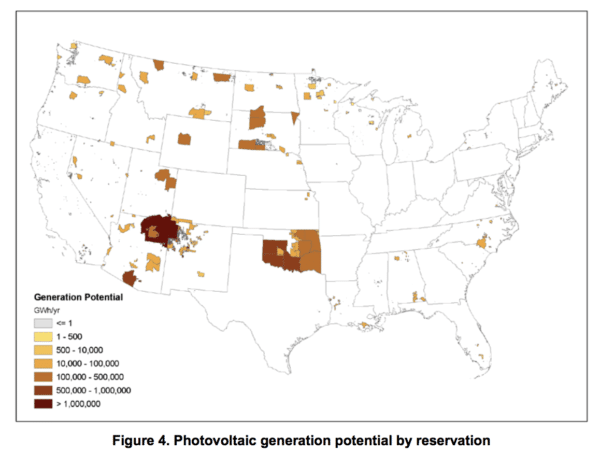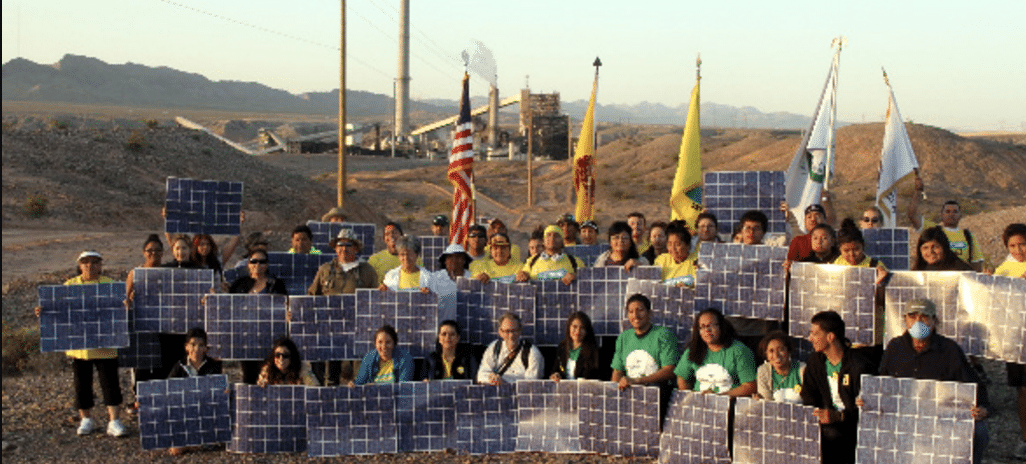By Will Driscoll
Native American tribes could install 61 gigawatts of utility-scale solar, and sell the resulting electricity wholesale at a profit, according to a report from the U.S. Department of Energy’s National Renewable Energy Laboratory (NREL). The potential for a specific tribal land area may be analyzed using NREL’s online Tribal Energy Atlas.
A new $2 billion federal loan guarantee program for energy developments on tribal lands can assist with financing.
NREL’s analysis first identified the technical solar potential on tribal lands (6,035 gigawatts), then estimated the levelized cost of energy (LCOE) for each location, and compared that to the levelized avoided cost of energy (LACE), which is based on regional wholesale market electricity prices. Where the LACE was higher than the LCOE, NREL identified “economic potential.” The result was 61 gigawatts (GW) of economic solar potential.

NREL did not estimate or include transmission costs in the LCOE, noting that “a subset of sites would likely hold enough economic potential to be examined in more depth for additional inputs such as transmission cost and interest of potential energy buyers.” (Electricity-intensive industries on tribal lands, possibly data centers, are another option that would not require transmission.)
Counterbalancing the omission of transmission costs, the analysis used solar cost data from 2015 and early 2016, and solar costs have declined dramatically since then.
The analysis used financing costs of 9%, from NREL’s 2017 Annual Technology Baseline report. It also assumed a ten percent investment tax credit, and that Tribes would be able to partner with a taxable entity to benefit from tax-based solar incentives.
A sensitivity analysis using a recent low price of natural gas ($2.45/Mmbtu) yielded the same amount of profitable solar: 61 GW. An analysis using a recent high price of natural gas ($7.18/Mmbtu) yielded a much larger amount of profitable solar: 266 GW.
If Native American tribes added tens of gigawatts of solar to regional grids, the wholesale electricity price would decline during periods of high solar generation. NREL noted that it did not model that scenario. Were that to happen, solar-plus-storage could support the value of solar generation.
NREL’s report acknowledged some limitations of its analysis, noting that “Future work in the economic potential assessment may include incorporating both in-region and out-of-region transmission costs; environmental benefits; policy drivers, such as renewable portfolio standards; and any sensitivities to tax-oriented policies.”
Alaska Native villages were not considered in the analysis, although they are included in NREL’s Tribal Energy Atlas.
Will Driscoll, MPA, JD, is an energy and environmental policy analyst who has worked primarily for the U.S. EPA via the contractor ICF Consulting. His recent work is at SaveTheClimate.us.
This content is protected by copyright and may not be reused. If you want to cooperate with us and would like to reuse some of our content, please contact: editors@pv-magazine.com.









By submitting this form you agree to pv magazine using your data for the purposes of publishing your comment.
Your personal data will only be disclosed or otherwise transmitted to third parties for the purposes of spam filtering or if this is necessary for technical maintenance of the website. Any other transfer to third parties will not take place unless this is justified on the basis of applicable data protection regulations or if pv magazine is legally obliged to do so.
You may revoke this consent at any time with effect for the future, in which case your personal data will be deleted immediately. Otherwise, your data will be deleted if pv magazine has processed your request or the purpose of data storage is fulfilled.
Further information on data privacy can be found in our Data Protection Policy.